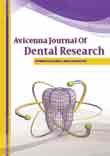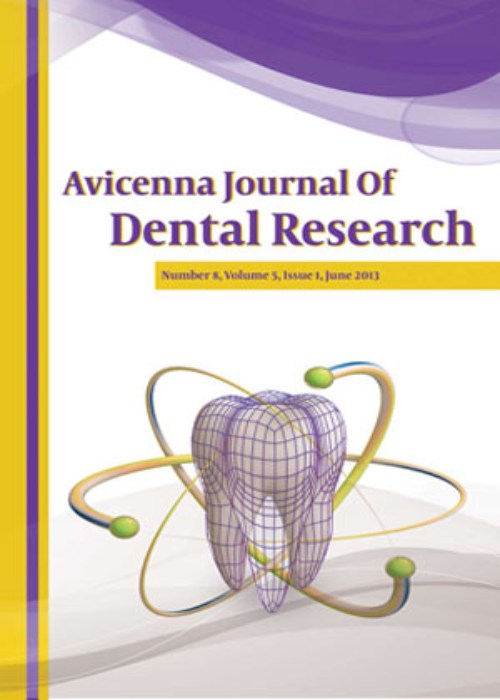فهرست مطالب

Avicenna Journal of Dental Research
Volume:9 Issue: 1, Mar 2017
- تاریخ انتشار: 1395/12/05
- تعداد عناوین: 8
-
-
Page 1Impaction of canine teeth is a clinical problem whose treatment usually requires an interdisciplinary approach. After the maxillary third molar, the maxillary canine is the second-most commonly impacted tooth, with an incidence of 1% - 2.5%. Maxillary canines are more common in females than males. This study reviews the surgical treatments and orthodontic considerations for impacted canines exposure reported in previous studies. The clinician should be aware of variations in the surgical management of labially and palatally impacted canines, as well as the most common methods of canine in orthodontic application, and the implications of canine extraction. The different factors that affect these decisions are discussed.Keywords: Surgical Procedures, Operative, Tooth, Impacted, Review Literature as Topic
-
Page 2BackgroundImpaction of third molars is a common phenomenon. The incidence of impacted third molars varies in different populations.ObjectivesThe aim of this study is to assess radiographic status (root development degree, angulation, and eruption level) of the third molar in Iranian population via panoramic radiographs.
Patients andMethods647 patients, ranging in age from 17 - 25, were selected from three regions of Iran. Based on their panoramic radiographs, their root development degree, angulation, and eruption levels were analyzed.ResultsThe angulation of upper third molars were vertical (44.6%), distoangular (44.1%), mesioangular (10.7%), and horizontal (0.6%). For lower third molars, the angulation was mesioangular (44.5%), vertical (33.8%), distoangular (12.2%), and horizontal (9.5%). The eruption levels of maxillary third molars were C > A> B, and for mandibular third molars they were A > B> C. The order of root development prevalence of the maxillary and mandibular third molars was complete > 2/3 > 1/3.ConclusionsThe most common status of impaction of the third molars in the maxilla was vertical angulation, level C of eruption, and complete root formation. In the mandible it was mesioangular, level A of eruption, and complete root formation. Since the study sample consists of patients from the north, middle, and south of Iran, the sample can represent the whole population of Iran.Keywords: Impaction, Eruption, Level, Development -
Page 3BackgroundDifferent enhancements have been used to improve the diagnostic accuracy of radiographic images in digital systems. However, the diagnostic accuracy of the effects of these enhancement options on dental caries has not been determined.ObjectivesThis study evaluated the effects of software enhancements of zooming, colorization, and contrast conversion on the accuracy of proximal caries detection.Materials And MethodsIn this diagnostic in vitro trial study, 42 non-cavitated and restoration-free extracted permanent molars and premolars were selected and mounted onto 14 blocks in contact with each other. Radiographic images were obtained from the teeth in similar standardized condition using the paralleling technique. The images were shown without any enhancement or with using the options of zooming, colorization, and contrast conversion. Depth of proximal caries was determined by a radiologist using four-scaled criteria. The diagnostic accuracy of digital images that had undergone different enhancements was calculated by the chi-square test.ResultsThe diagnostic odds of the original digital images were lower than 20 (5.7). By using the enhancement options of zooming, colorization, and contrast conversion, the diagnostic odds of the enamel proximal caries had a score of less than 20. The score was higher than 20 for proximal caries located in the outer and inner half of the dentin.ConclusionsThe enhancement options of zooming, colorization, and contrast conversion did not significantly influence the diagnostic accuracy of digital images in enamel caries, but they enhanced caries diagnosis/progression in the outer and inner half of the dentin.Keywords: Colorization, Contrast Conversion, Enhancement, Proximal Caries, Zooming
-
Page 4BackgroundThe width ratio of teeth is an important factor in dental and facial esthetics. The Golden proportion (62%) and the recurring esthetic dental proportion (RED) are two theories in this field that have been suggested to create harmony among anterior teeth. These have rarely been studied among the Iranian population.ObjectivesThe aim of this study was to evaluate the Golden proportion and RED proportion in students, staff, and patients of Shahed dental school.
Patients andMethodsThis study was conducted with 116 subjects in Shahed dental school photographs of the subjects anterior teeth were taken from the frontal view. The perceived width ratios of canine to lateral incisor and lateral incisor to central incisor were calculated. In this study, the Golden proportion was evaluated within the range of 0.55 0.64. To evaluate the existence of the RED proportion in each subject, the width ratio of canine to lateral incisor was compared with the width ratio of lateral incisor to central incisor.ResultsThe Golden proportion existed in 25% of the perceived width ratios of lateral incisor to central incisor, and 2.1% of the width ratios of canine to lateral incisor in natural dentition. The RED proportion existed in 18.5% of subjects, and the most recurring proportion was 0.73 in these subjects.ConclusionsThe Golden proportion and the RED proportion cannot be used as constant proportions to create a harmonious proportion throughout the width of maxillary anterior teeth.Keywords: Dental Arch, Dental Photography, Tooth Crown -
Page 5BackgroundColor change is one major drawback of tooth-colored resin-based restorations.ObjectivesThis study aimed to assess the color stability of three commonly used resin-based restorative materials upon exposure to tea and coffee.Materials And MethodsDiscs were fabricated from Spectrum TPH (Dentsply/Caulk), Denfil (Vericom), and Filtek Z250 (3 M) microhybrid composites and immersed in coffee and tea solutions for two hours on the first day and the whole of the second, third, and fourth days. The color was assessed visually and recorded using the Lobene Stain Index after each period of immersion. The color change of the three composite resins was compared using the Kruskal-Wallis test, Mann-Whitney U test, and Friedman test. The level of significance was set at 0.05. The Cohens Kappa was also calculated to assess inter-rater agreement.ResultsThe three composite resins showed statistically significant color changes after four days of immersion in a coffee solution (P = 0.014), but their color change in the tea solution was not significant (P > 0.05). A comparison of color changes in the composites after one (two hours) and four days of immersion in tea and coffee solutions revealed a significant difference in color changes between Spectrum TPH and the other two composites (PConclusionsThe three microhybrid composites used in this study showed variable color stability upon exposure to a coffee solution. The color stability of Spectrum TPH was inferior to that of Denfil and Filtek Z250.Keywords: Composite Resins, Composite Resins, Color, Discoloration
-
Page 6BackgroundDental implants are increasingly used in resorbed alveolar ridges, and the success of implants inserted concomitantly with guided bone regeneration (GBR) needs to be evaluated.ObjectivesThis study aimed to clinically and radiographically assess the peri-implant tissues in the posterior maxilla and mandible in cases in which dehiscence or fenestration occurred at the time of implant surgery and treated with GBR (simultaneously with implant placement in one session). A comparison was also made between the above-mentioned patients and controls in which implants were placed in intact bone (entire length of implant in bone).
Patients andMethodsThis study was conducted on 12 patients as cases who received 17 standard implants (dehiscence or fenestration occurred after placement of 4 mm diameter standard implants and GBR was performed) and 10 patients as the control group (those who received 17 standard implants, 4 mm in diameter and 10 mm in length, in adequate bone). Periapical (PA) radiographs were obtained in the first 24 hours post-surgery. Radiographs were repeated at one month, at the time of loading (two months post-surgery), and at three and six months after loading to assess marginal bone loss. To assess the peri-implant soft tissue, thickness and width of the keratinized gingiva were evaluated. Data were analyzed using t-test and repeated measures analysis of variance. The level of significance was set to P = 0.05.ResultsThe difference in distance from the bone crest to the implant shoulder between the two groups of cases and controls was significant at the following time points: baseline and 2 months post-surgery (P = 0.000), baseline and 6 months after loading (P = 0.01), 2 months post-surgery and 3 months after loading (P = 0.00), and 2 months post-surgery and 6 months after loading (P = 0.00). Changes in the width of the keratinized gingiva were not significant in the two groups of cases and controls at 2 months post-surgery (P = 0.87) or at 6 months after loading compared with the baseline preoperative values (P = 0.47). Changes in the thickness of the keratinized gingiva were not significant in the case or control group at 2 months post-surgery (P = 0.97) or at 6 months after loading compared with the baseline preoperative values (P = 0.25).ConclusionsChanges in the marginal bone level were greater when implants were placed concomitantly with GBR. No significant difference was noted in terms of changes in width or thickness of the keratinized gingiva between the two groups.Keywords: Dental Implant, Guided Bone Regeneration, Dehiscence, Fenestration -
Page 7BackgroundExperimental dentin bonding systems containing nanoclay fillers have shown high microleakage, which may be due to the high concentration of hydroxyethylmethacrylate (HEMA) in their composition.ObjectivesThis study sought to assess the effect of using different concentrations of HEMA in an experimental dentin bonding system containing PAA-g-nanoclay on the degree of conversion and microleakage of class V composite restorations.MethodsThis in vitro experimental study was conducted on 60 class V cavities prepared in the buccal and/or lingual surfaces of sound-extracted premolar teeth. The cavities were restored using an experimental dentin bonding agent containing PAA-g-nanoclay and a light-cure composite in three groups (n = 20) with a HEMA concentration of 15% (group 1), 20% (group 2), and 30% (group 3) in the adhesive. After thermocycling, microleakage was assessed at the occlusal and gingival margins of the restorations using the dye penetration method. The degree of conversion of the dentin bonding agent was calculated using Fourier transform infrared spectroscopy. The data was analyzed using SPSS version 16 and the Kruskal-Wallis, Fishers exact, Wilcoxon, and Mann-Whitney tests (α = 0.05).ResultsMicroleakage at the occlusal and gingival margins was not significantly different between the three groups (P > 0.05), but the difference in microleakage between the occlusal and gingival margins was significant within each group (P 0.05).ConclusionsBased on the results, HEMA concentrations of 15%, 20%, and 30% in our experimental bonding agent had no effect on the microleakage of class V restorations. They were not significantly different in terms of degree of conversion either.Keywords: Photoinitiator, Microleakage, Degree of Conversion, Dentin Bonding Agent
-
Page 8IntroductionThe orthokeratinized odontogenic cyst (OOC) is an uncommon developmental cyst that occurs between the second to fifth decades, more commonly in males. It is a solitary lesion that mostly occurs in the mandible rather than the maxilla. Histologic features include a thin, uniform epithelial lining with orthokeratinization and a prominent granular layer below a non-corrugated onion-skin-like surface.Case PresentationA 40-year-old man presented with pain and swelling in the left mandibular canine molar area. The panoramic radiograph revealed a well-defined radiolucency extending from the left mandibular canine to the left mandibular molar, with scalloped projections between the teeth roots. Microscopic examination showed a cystic lesion lined by an orthokeratinized stratified squamous epithelium, and a prominent granular layer beneath the cornified layer was seen. The features were those of an OCC.ConclusionsFrom the demographic and radiographic perspectives, the features of OOCs can be similar, but more variation can be found on routine histopathological analyses.Keywords: Odontogenic Cyst, Jaw, Developmental


